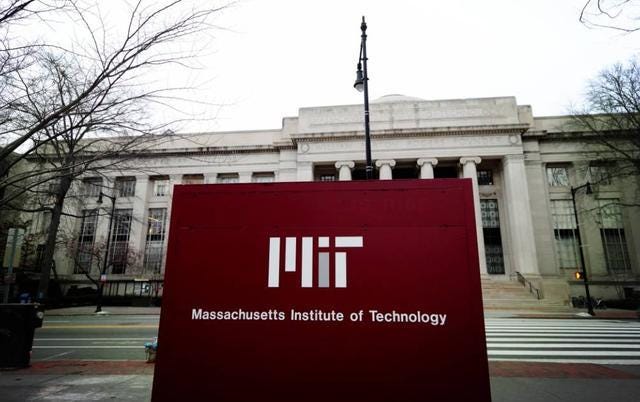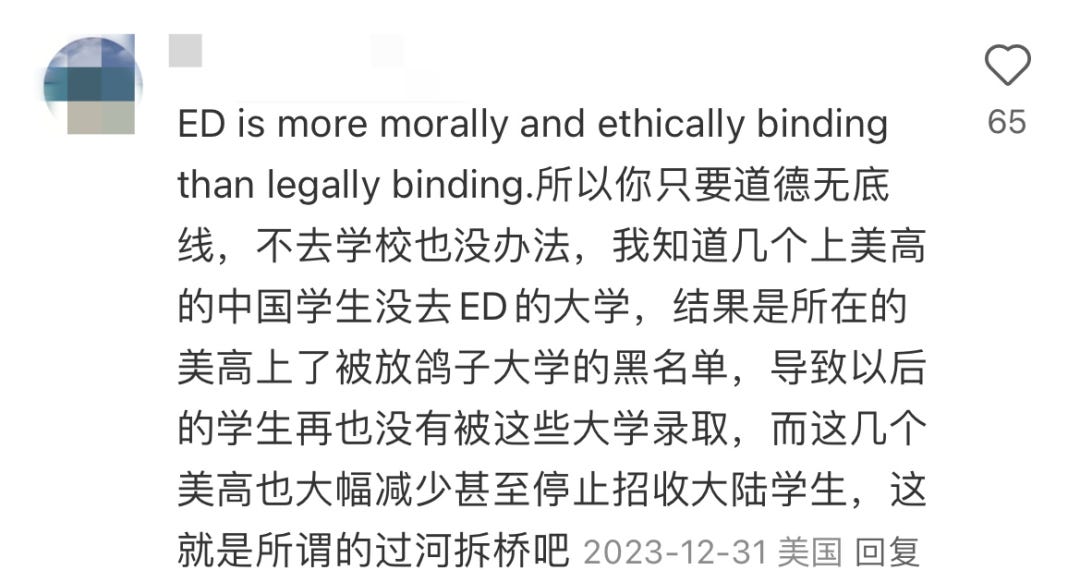Chinese student admitted to MIT faces allegations of misconduct, with suspicions of breaching the Early Decision (ED) agreement.
Following the recent online harassment incident involving an MIT female student, another issue in the international student community has sparked intense discussions in the past few days.
A 23rd-year Chinese student, who had secured admission to the University of Pennsylvania through the Early Decision (ED) process, found herself in the spotlight after receiving a "likely letter" from MIT during the Early Action (EA) phase. She subsequently changed her course and decided to enroll at MIT, reneging on her commitment to the University of Pennsylvania. This incident has ignited fervent conversations across social media platforms.
It's important to note that the ED application process typically allows students to apply to only one university, with a binding agreement that they must enroll if accepted. In essence, when students apply through ED, both the university and the student enter into a binding contract.
The only circumstances under which students can "break" this agreement are typically when they face significant financial hardships and the school cannot provide adequate financial aid, or in cases of severe emergencies, such as serious illness, where students may need to take a gap year or leave of absence. In such situations, students are required to communicate their circumstances to the school and reach an amicable agreement with the institution before being allowed to rescind their commitment. However, according to online accounts, this Chinese student came from a financially well-off background, as she was attending a private American high school. Additionally, although she did take a gap year, whether it qualifies as an emergency gap year remains uncertain.
So, why has this incident generated such a strong reaction?
To illustrate, consider a scenario where Student A, during the ED phase, is only admitted to New York University (NYU). However, during the Regular Decision (RD) phase, Student A receives an offer from Harvard University. Legally, NYU may not have grounds to sue Student A if they choose to attend Harvard, but their breach of trust could potentially affect the high school community. NYU might blacklist the high school attended by Student A, potentially resulting in reduced or discontinued admissions for their future students. Furthermore, if such a breach is reported to the university, Student A may risk having their admission offer revoked.
This incident underscores the importance of ethical behavior and adherence to contractual obligations within the college admissions process, with potential consequences extending beyond the individual student's academic journey.
Especially for elite universities, students can significantly increase their chances of receiving an offer by applying through Early Decision (ED).
In most cases, the likelihood of being admitted can triple. For schools like the Ivy League institutions, the odds can even be more than five times higher.
The following chart displays admission statistics for the Class of 2022 at the eight Ivy League schools. The yellow section represents the Regular Decision (RD) acceptance rates, while the green section represents the Early Decision (ED) acceptance rates.
Here are the specific data:
Brown University: Regular acceptance rate is 5.7%, Early acceptance rate is 21.0%.
Columbia University: Regular acceptance rate is 4.3%, Early acceptance rate is 15.9%.
Cornell University: Regular acceptance rate is 8.3%, Early acceptance rate is 24.3%.
Dartmouth College: Regular acceptance rate is 6.9%, Early acceptance rate is 24.9%.
Harvard University: Regular acceptance rate is only 2.8%, Early acceptance rate is 14.5%.
University of Pennsylvania: Regular acceptance rate is 6.5%, Early acceptance rate is 18.5%.
Princeton University: Regular acceptance rate is 3.8%, Early acceptance rate is 14.8%.
Yale University: Regular acceptance rate is 4.7%, Early acceptance rate is 14.7%.
It is evident that applying through Early Decision (ED) offers a significantly higher chance of admission compared to the Regular Decision (RD) process. This is why we have seen a substantial 41% increase in early applicants for the 2023-24 academic year, especially after the adoption of standardized test-optional policies.
The underlying logic is that ED already had admission rates several times higher than RD, and now, with the elimination of SAT/ACT requirements, even students who may not excel in standardized tests are eager to participate in the ED pool. Consequently, the competition for ED spots has intensified.
However, it's important to note that ED is a binding commitment. Once a student applies to a particular school through ED, it is akin to sending a "letter of intent" to that school, expressing, "You are my first choice, and I am ready to make a commitment."
American universities aim to increase their yield rates and do not want to be considered backup options for students. Therefore, they are more inclined to admit a higher number of applicants through the ED round.
Nevertheless, some students take risks by trying to "have it both ways," such as applying to multiple private universities through ED or failing to withdraw their Early Action (EA) or RD applications even after successfully securing an ED offer. According to ED rules, early acceptees are required to confirm their intent to enroll within a few weeks of receiving the offer and must decline any other admission offers from different schools.
In summary, when ED decisions are released in December each year, if you receive an offer through ED, you should proactively withdraw any previously submitted RD applications. Forgetting to do so or failing to promptly decline offers from other schools during the RD phase is not only a breach of the contractual spirit but also raises ethical concerns, as it does not afford fair opportunities to other deserving students.
The consequences of breaching an Early Decision (ED) agreement can sometimes be underestimated.
For instance, some individuals argue that criticizing ED contract violations is taking a moral high ground and that when students have better options, they don't need to honor their commitments.
Indeed, the circumstances can vary from one school to another, and some students who breach their ED agreements may manage to evade a "loyalty check" successfully by keeping both institutions in the dark. However, once such disloyal behavior on both ends is discovered, the consequences go beyond both universities withdrawing their offers; it can also affect the high school. This is one of the reasons why netizens are so deeply outraged.
In the comments section, some individuals with inside knowledge have mentioned that they are aware of several Chinese students who attended private American high schools but chose not to enroll at the ED university they were admitted to. As a result, their high schools placed them on blacklists related to the universities involved.
On Quora, discussions on this topic among American internet users are also quite heated.
One Quora user shared an example from their local area, where a student gained ED admission to the University of Pennsylvania but chose to forego enrollment six years ago. To this day, the University of Pennsylvania has refused to admit any students from that particular high school.
Indeed, adhering to the Early Decision (ED) commitment is not only a responsibility to oneself but also to others.
Additionally, American universities are not lenient when it comes to ED breaches. Many U.S. colleges engage in information sharing, including Ivy League schools and the Coalition for College, which comprises about 30 universities. They often share lists of early applicants and their information. Katharine Fretwell, the Director of Admission and Financial Aid at Amherst College, confirmed the existence of such shared lists in an interview.
When a school identifies the same name appearing in both their ED applicant pool and that of another institution, it is highly likely that both universities will reject the applicant.
Furthermore, while a university won't physically force you to enroll if you choose not to attend the ED-admitting school, nor will they take you to court and make you pay tuition for four years, they may inform other schools of your contract violation. This is akin to how local bars may post the names of individuals who wrote bad checks. As a result, other universities may also reject you because you had previously committed to enroll at an ED-admitting institution.
Moreover, just like reporting a leak of A-level exam questions, if anyone observes an ED breach in their surroundings, counselors, alumni, fellow students, and parents have the right to report it to the university's admissions department.
For school counselors, the stakes are even higher because they must safeguard the school's reputation and assist future applicants. Consequently, many school counselors and college advisors strictly prohibit students from applying to multiple universities through ED.
Indeed, applying through Early Decision (ED) can offer numerous benefits, including a higher chance of admission to top-tier universities and the opportunity for students to relax and enjoy their final semester of high school without the stress of college applications.
However, ED also comes with hidden risks, and it may not be suitable for all students, especially those who are still unsure about their academic goals.
Christoph Guttentag, the Dean of Undergraduate Admissions at Duke University, emphasizes the importance of researching colleges thoroughly if students are considering applying through ED.
This is because if a student applies through ED without fully understanding the school and later discovers that it is not their preferred choice, they may find themselves in a situation where they have to attend a college that does not make them happy.
Additionally, for students who require financial aid, applying through Regular Decision (RD) can be advantageous as it allows them to compare different schools' generosity in providing financial assistance, enabling them to make the best possible choice.
Therefore, the key to a successful ED application is a thorough understanding of oneself and the colleges being considered.
Back to the reporting incident itself, any news involving falsification or unethical practices in college applications, especially at prestigious institutions, tends to deeply unsettle people.
However, it's important to understand that thousands of parents invest millions, even tens of millions of dollars, in the American college admissions process. Moreover, when it comes to top-tier schools like MIT, it's worth noting that in recent early admission cycles, MIT admitted only a handful of students from mainland China. In this highly competitive arena, it's nearly a zero-sum game. When one student secures admission, hundreds or even thousands of others face rejection.
If a student is admitted based on their genuine qualifications and achievements, there's nothing to dispute. However, when there are elements of deception and dishonesty involved, especially in this age of big data, the facade of lies becomes fragile and easily shattered.
Tides always recede, and at such times, it becomes clear who has been swimming naked.












